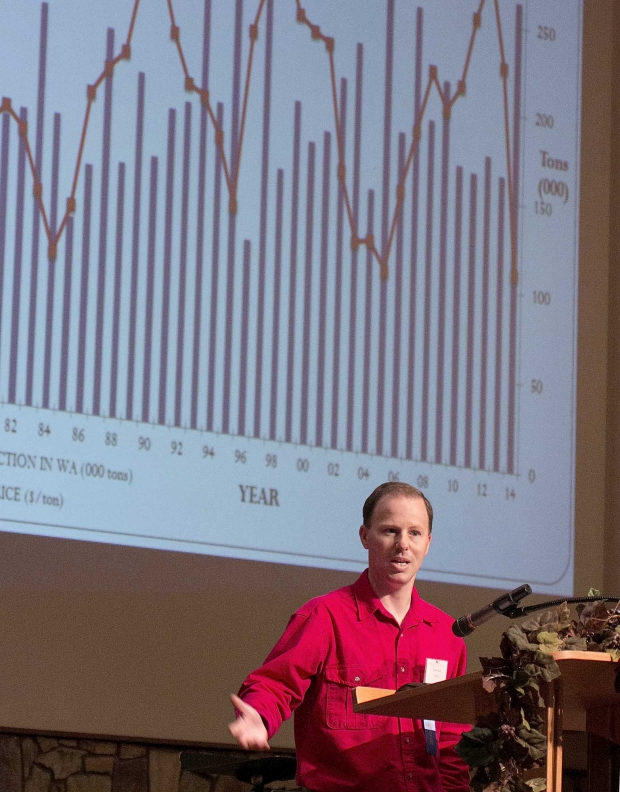
Trent Ball discusses the 2014 Concord grape crop during the Washington State Grape Society’s annual meeting in Grandview, Washington on November 13, 2014. (TJ Mullinax/Good Fruit Grower)
The year 2014 will be remembered by Washington State’s grape industry as having one of the biggest crops on record for both juice and wine grapes. For wine grape growers, the long, warm growing season resulted in a near perfect vintage.
But many juice grape growers struggled to reach minimum sugar concentrations due to heavy crop loads, and for those selling on the cash market, prices tumbled to levels not seen in a decade.
For the last decade, Washington, which is the nation’s leading juice grape producer, has produced an annual statewide average of around 190,000 tons.
The 2014 crop, which wrapped up harvest in mid-November, is estimated to reach 264,000 tons, according to Dr. Trent Ball, who spoke during the Washington State Grape Society’s annual meeting last Thursday in Grandview.
“We had a very warm growing year in Washington and a spectacular fall,” said Ball, partner in Agri-Business Consultants LLC and director of the viticulture and enology program at Yakima Valley Community College.
Ball is annually contracted to report on juice and wine grape production and provide an economic outlook at the Grape Society meeting.
“It was one of the earliest starts for both wine and juice grape harvests and yields for juice grapes were extremely high, some of the biggest on record,” he said. “The berries just continued to size in the fall and get bigger and bigger.”
Exceptional tonnage
Concord grape production in the state for 2014 averaged more than 12 tons per acre, up significantly from 7.7 tons per acre last year and 8.3 tons per acre in 2012. Niagara, a white grape variety, averaged 17.2 tons per acre, setting a new state record. The previous record average for Niagara was 14.8 tons per acre.
Other juice grape producing regions in the United States also had big crops. New York, the nation’s second largest producer, had a bigger crop than expected, which helped push the national Concord crop to around 517,660 tons.
“When you compile the 2013 and 2014 U.S. crops of around 970,000 tons, it results in the largest consecutive totals for many years,” said Ball. The buildup of Concord concentrate inventories depressed the cash price for Washington Concords to around $110 per ton, a dramatic drop from last year’s cash price of $225 per ton and $280 per ton in 2012.
“We knew the cash price would come down, but going from $280 to $110 is a pretty dramatic drop,” he said. Cash prices haven’t been that low since 2004 and 2005.
Prices for Concord concentrate (called concentrate 68 Brix) are at $8.50 per gallon in Washington and $10.50 on the East Coast. They, too, are also at their lowest since the mid-2000s.
Three years ago, concentrate was selling for more than $20 per gallon, Ball said. “The negative to having a high concentrate price is that it opens the door for competition from alternative and imported products. Hopefully, this lower price will bring about more use of Concord concentrate.”
He reported that 63.7 million gallons of single-strength juice and concentrate were imported to the United States in 2013, up from 58.9 million gallons in 2013.
“The larger-than-anticipated juice grape crop did create problems for some growers in meeting minimum quality standards,” said Craig Bardwell of National Grape Cooperative Association, the juice-processing arm for Welch Foods. “It was a challenging crop and there were a number of rejected loads.” There were a few instances where blocks didn’t get picked because fruit didn’t meet minimum sugar requirements of 16° Brix.
Although the numbers are still being finalized, Ball estimated Washington’s wine grape crop would reach 240,000 tons and be the largest crop on record. The increased volume is a result of new acreage coming into production. Some 50,000 acres of wine grapes are planted in Washington, according to industry sources.
National wine sales are up 5 percent from the same time a year ago, and the industry is still in a growth mode. Final crop numbers for Washington will be released in early 2015.






Leave A Comment